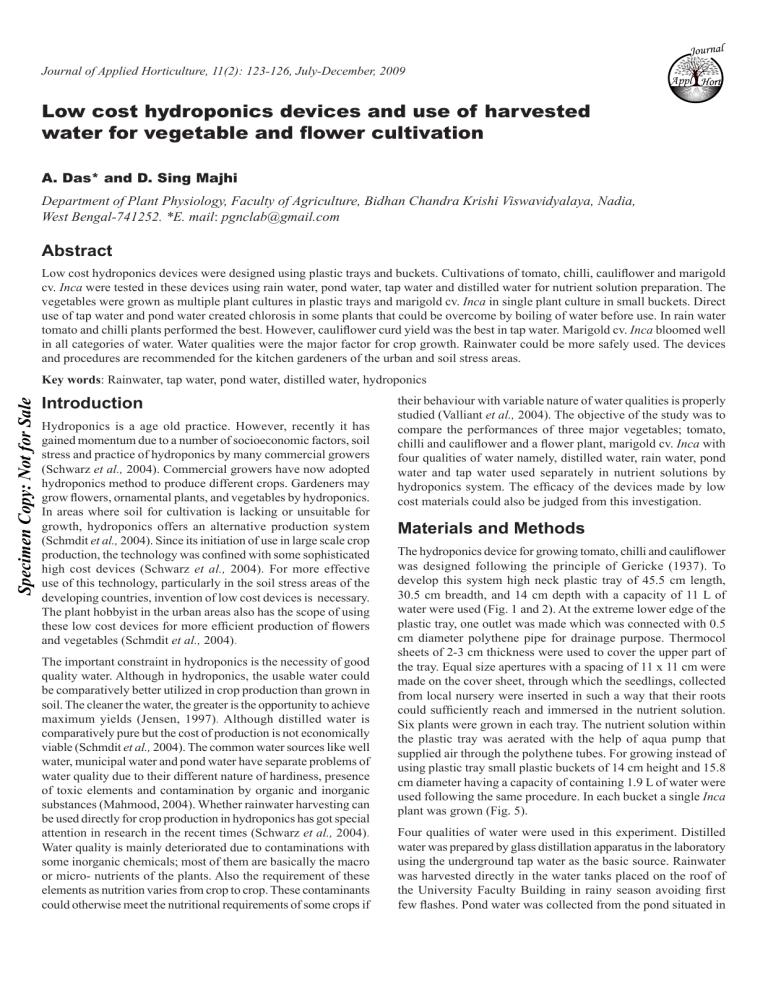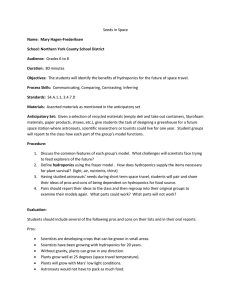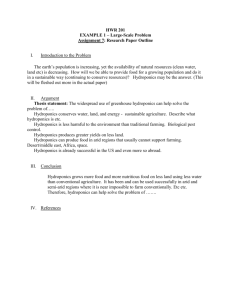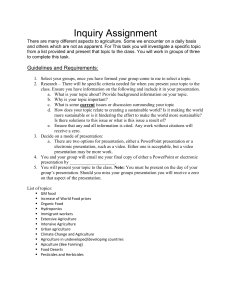
Journal Journal of Applied Horticulture, 11(2): 123-126, July-December, 2009 Appl Low cost hydroponics devices and use of harvested water for vegetable and flower cultivation A. Das* and D. Sing Majhi Department of Plant Physiology, Faculty of Agriculture, Bidhan Chandra Krishi Viswavidyalaya, Nadia, West Bengal-741252. *E. mail: pgnclab@gmail.com Abstract Low cost hydroponics devices were designed using plastic trays and buckets. Cultivations of tomato, chilli, cauliflower and marigold cv. Inca were tested in these devices using rain water, pond water, tap water and distilled water for nutrient solution preparation. The vegetables were grown as multiple plant cultures in plastic trays and marigold cv. Inca in single plant culture in small buckets. Direct use of tap water and pond water created chlorosis in some plants that could be overcome by boiling of water before use. In rain water tomato and chilli plants performed the best. However, cauliflower curd yield was the best in tap water. Marigold cv. Inca bloomed well in all categories of water. Water qualities were the major factor for crop growth. Rainwater could be more safely used. The devices and procedures are recommended for the kitchen gardeners of the urban and soil stress areas. Specimen Copy: Not for Sale Key words: Rainwater, tap water, pond water, distilled water, hydroponics Introduction Hydroponics is a age old practice. However, recently it has gained momentum due to a number of socioeconomic factors, soil stress and practice of hydroponics by many commercial growers (Schwarz et al., 2004). Commercial growers have now adopted hydroponics method to produce different crops. Gardeners may grow flowers, ornamental plants, and vegetables by hydroponics. In areas where soil for cultivation is lacking or unsuitable for growth, hydroponics offers an alternative production system (Schmdit et al., 2004). Since its initiation of use in large scale crop production, the technology was confined with some sophisticated high cost devices (Schwarz et al., 2004). For more effective use of this technology, particularly in the soil stress areas of the developing countries, invention of low cost devices is necessary. The plant hobbyist in the urban areas also has the scope of using these low cost devices for more efficient production of flowers and vegetables (Schmdit et al., 2004). The important constraint in hydroponics is the necessity of good quality water. Although in hydroponics, the usable water could be comparatively better utilized in crop production than grown in soil. The cleaner the water, the greater is the opportunity to achieve maximum yields (Jensen, 1997). Although distilled water is comparatively pure but the cost of production is not economically viable (Schmdit et al., 2004). The common water sources like well water, municipal water and pond water have separate problems of water quality due to their different nature of hardiness, presence of toxic elements and contamination by organic and inorganic substances (Mahmood, 2004). Whether rainwater harvesting can be used directly for crop production in hydroponics has got special attention in research in the recent times (Schwarz et al., 2004). Water quality is mainly deteriorated due to contaminations with some inorganic chemicals; most of them are basically the macro or micro- nutrients of the plants. Also the requirement of these elements as nutrition varies from crop to crop. These contaminants could otherwise meet the nutritional requirements of some crops if their behaviour with variable nature of water qualities is properly studied (Valliant et al., 2004). The objective of the study was to compare the performances of three major vegetables; tomato, chilli and cauliflower and a flower plant, marigold cv. Inca with four qualities of water namely, distilled water, rain water, pond water and tap water used separately in nutrient solutions by hydroponics system. The efficacy of the devices made by low cost materials could also be judged from this investigation. Materials and Methods The hydroponics device for growing tomato, chilli and cauliflower was designed following the principle of Gericke (1937). To develop this system high neck plastic tray of 45.5 cm length, 30.5 cm breadth, and 14 cm depth with a capacity of 11 L of water were used (Fig. 1 and 2). At the extreme lower edge of the plastic tray, one outlet was made which was connected with 0.5 cm diameter polythene pipe for drainage purpose. Thermocol sheets of 2-3 cm thickness were used to cover the upper part of the tray. Equal size apertures with a spacing of 11 x 11 cm were made on the cover sheet, through which the seedlings, collected from local nursery were inserted in such a way that their roots could sufficiently reach and immersed in the nutrient solution. Six plants were grown in each tray. The nutrient solution within the plastic tray was aerated with the help of aqua pump that supplied air through the polythene tubes. For growing instead of using plastic tray small plastic buckets of 14 cm height and 15.8 cm diameter having a capacity of containing 1.9 L of water were used following the same procedure. In each bucket a single Inca plant was grown (Fig. 5). Four qualities of water were used in this experiment. Distilled water was prepared by glass distillation apparatus in the laboratory using the underground tap water as the basic source. Rainwater was harvested directly in the water tanks placed on the roof of the University Faculty Building in rainy season avoiding first few flashes. Pond water was collected from the pond situated in 124 Low cost hydroponics devices and use of harvested water for vegetable and flower cultivation front of the faculty building of the university. The tap water was the underground lifted water from the laboratory water supply. The chemical analysis of four water samples was done by the Water Testing Laboratory, Department of Agriculture Chemistry, BCKV. The nutrient solution was prepared following Hoagland and Arnon (1950). The nutrient solutions were refreshed as per the requirement of the plants keeping always the same composition of nutrients. The total amount of nutrients as well as water supplied to the plants was recorded. problem didn’t arise further. Chemical analysis of four water samples used in this experiment is shown in Table 1. According to the crop irrigation water quality standards described by Ayers and Westcot (1994), none of the water samples crossed the level of severity that could damage crop growth. However, in tap water and pond water, the level of bicarbonate, calcium, magnesium, chloride, sodium, potassium and iron were much higher than in rain water and distilled water (Table 1). The high bicarbonate level indicated the higher temporary alkalinity level of water used in nutrient solution that made precipitation causing mineral nutrition deficiencies in the plants (Schwarz et al., 2004). By boiling water prior to use, this temporary alkalinity level could be reduced by allowing precipitation of carbonate compounds with ions like calcium and magnesium present in the water. The water having reduced alkalinity level was thus made safe for both nutrient solution preparations as well as plant growth (Schwarz et al., 2004). The distilled water used in this experiment was directly prepared from tap water by single distillation and as a result trace amount of different elements were retained (Table 1). The elements found in the rain water sample used in this experiment might be due to air pollution (Khare et al., 2004). Results and discussion Specimen Copy: Not for Sale There was no problem in growing the plants of tomato, chilli and cauliflower in the multiple plant culture device of hydroponics used in the experiment. 5-6 plants of tomato and chilli and 3-4 plants of cauliflower could be grown well within a tray as shown in the Figs. 1, 2 and 3. Their yield performances varied due to the effect of different qualities of water, but not due to problems in the devices. The performance of marigold cv. Inca was best suited in single plant culture device as shown in the Fig. 5. Chlorotic symptoms due to mineral nutrition deficiencies were noticed in the tomato plants grown in pond water solution and the chilli and cauliflower plants grown in both pond water and tap water solutions after 20-25 days of planting. In other treatments, including the Inca plants no such symptoms were noticed. At the same time precipitation was also noticed in the nutrient solutions of the respective tanks. To solve this problem, both pond and tap water were boiled for 30 minutes, allowed to settle down for few hours and then strained through muslin clothes prior to use. Water samples prepared in this way were further used for nutrient solutions. The chlorotic plants could revive their normal health within 7-10 days after refreshing in new solutions and the The observations on further crop growth in four categories of water solutions showed that tomato plants performed well in all of them. However, variations in growth patterns were distinct among the treatments. At 120 days growth of the plants the total dry matter accumulation in the shoot of tomato plants, number of flowers/plant, average number of fruits/plant grown in rain water solution was much higher than that in other solutions (Table 2). The percentage of successful fruit bearing (62%) was also the highest in the plants grown in rain water solution. The total water requirement of the plants had not wide differences among the treatments however, the added nitrate nutrient in the solution was Table 1. Chemical analysis of different water samples Parameters pH Electrical conductivity (mmhos cm-1) Bicarbonate (mg L-1) Calcium (mg L-1) Magnesium (mg L-1) Nitrate (mg L-1) Ammonium (mg L-1) Phosphate (mg L-1) Sulphate (mg L-1) Boron (mg L-1) Chloride (mg L-1) Sodium (mg L-1) Potassium (mg L-1) Iron (mg L-1) Manganese (mg L-1) Zinc (mg L-1) Copper (mg L-1) Water quality Distilled water 6.75 0.002 0.083 0.80 0.78 0.78 0.08 0.09 0.00 0.00 1.875 1.25 0.125 0.046 0.005 0.007 0.100 Rain water 5.99 0.40 0.133 20.04 19.51 1.50 0.05 0.26 0.00 0.038 0.625 2.50 0.750 0.320 0.017 0.015 0.001 Table 2. Growth parameters of tomato plants grown in four water solutions Treatments Dry weight of Flowers Fruits shoot per plant per plant (g) Distilled water 28.91 45.34 26.67 Rain water 38.37 46.50 28.50 Pond water 28.72 46.34 16.34 Tap water 28.70 42.00 16.83 LSD (P=0.05) 8.92 3.71 3.43 Pond water 7.19 0.72 0.337 41.68 48.39 1.78 0.76 0.25 3.99 0.032 10.621 23.10 5.500 0.745 0.035 0.031 0.00 Average fruit weight (g) 34.66 35.42 30.56 30.36 5.54 Total nitrate accumulation/ plant(g) 7.518 9.111 7.341 7.734 - Tap water 7.41 0.71 0.279 71.34 81.17 1.66 0.17 0.48 0.00 0.026 8.125 18.10 3.250 0.476 0.064 0.146 0.001 Total water requirement/ plant (L) 10.69 9.94 10.18 10.04 - 125 Specimen Copy: Not for Sale Low cost hydroponics devices and use of harvested water for vegetable and flower cultivation Fig. 1. Tomato plants grown in rain water solution. Fig. 2. Chilli plants grown in rain water solution. Fig. 3. Cauliflower grown in rain water solution showing browning symptoms in curd. Fig. 4. Normal cauliflower curd formation in tap water solution. Fig. 5. Marigold cv. Inca grown in a) rain water, b) distilled water c) tap water and d) pond water solutions. much higher in the plants grown in rain water solution than in all other treatments (Table 2). For tomato plants, adequate supply of NPK and micro nutrients like Zn, Cu, and B is essential for dry matter accumulation, number of flowers, fruit quality and fruit size (Kallo et al., 2003). Availability of these particular nutrients varied among the treatments and was better in rainwater solutions that was reflected in crop yield. The variations in growth patterns of chilli plants were also distinct among the four treatments. At 165 days of growth, the total dry matter accumulation in shoot was much higher in the plants grown in rain water solution and distilled water solution than that of tap water and pond water solutions (Table 3). The plants grown in distilled water and rain water solutions had earlier initiation of flowering and fruiting and higher average number of fruits/plant than tap water and pond water solutions. The total water and nutrition added was highest in rain water solution followed by distilled water treatment (Table 3). Chilli plants prefer nitrate nitrogen and a proper balance of nitrate and ammonium nitrogen is recommended that might affect vegetative growth and delay in maturity (Despande, 2003). The common nutrients added to each treatment in this experiment had only nitrate nitrogen and no ammonium nitrogen (Hoagland and Arnon, 1950). However, the presence of ammonium in the pond water and tap water were initially much higher than rain water and distilled water (Table 1). 126 Low cost hydroponics devices and use of harvested water for vegetable and flower cultivation Specimen Copy: Not for Sale Table 3. Growth parameters of chilli plants grown in four water solutions Treatments Dry weight of Initiation of Initiation of shoot flowering fruiting (g) (days) Distilled water 20.77 47 62 Rain water 22.49 51 66 Pond water 12.20 68 83 Tap water 11.37 71 86 6.97 9.3 9.3 LSD (P=0.05) Flowers per plant Fruits per plant 115.50 96.17 79.00 73.67 25.52 48.50 45.50 29.67 34.50 12.61 Total nitrate Total water accumulation/ requirement/ plant plant (g) (L) 12.94 11.95 14.47 13.15 10.30 9.54 8.89 8.28 This might have disturbed the necessary balance of nitrate and ammonium nitrogen in the solutions and affected the plant growth in these two treatments. using pond and tap water, which are usually highly contaminated, crops’ nutritional requirements and chemical compositions of water should be considered. In case of cauliflower, within a period of 80 days growth, the total dry matter accumulation (35.64 g, excluding the curd) in the plants grown in tap water solution was much higher than the other treatments (20-25 g). The total water and nutrition added during the entire crop growth period were also much higher in these two treatments. Among the four treatments there were distinct differences in curd formations. The curds formed in the plants grown in rainwater and distilled water solutions showed browning symptom (Fig. 3). Such physiological disorders in cauliflower usually happens due to micronutrient deficiencies like magnesium, boron and molybdenum (Singh and Sharma, 2003). No such abnormalities in curd development were noticed in the plants grown in pond water and tap water (Fig 4). The highest curd weight (350g) was observed in the plants grown in the tap water. It appeared from the result that the nutrient solutions prepared by rain water and distilled water could not provide sufficient micronutrients. As the initial micronutrient content were high in tap water and pond water (Table 1) it could be properly utilized by the plants for normal curd formations. The present study indicates the successful way of low cost hydroponics which can be practiced by different cross sections of people. Apart from its commercial implications if such low cost hydroponics is used in a transparent container, although simple but that will definitely pave the way for the study of root system, the plant part which till date is poorly studied compared to other plant parts. Marigold cv. Inca could be grown well in the single plant culture devices. The plants came into flowering within 40-45 days after planting and continued blooming for next two months. There were no significant differences in the estimated vegetative growth parameters, root growth and flowering (20-25 in number) among the plants grown in different water treatments (Fig 5 a-c). There was no problem of precipitation in this culture by direct use of tap water or pond water. The results indicated that this plant had more tolerance to alkalinity stress as well as water quality status than the other plants used in this experiment. In the low cost hydroponics devices designed for this experiment, different crops could be grown satisfactorily. It was estimated that from each plastic tray of 45.5 x 30.5 x 14 cm size, 5.8 kg tomato, 1.5 kg chilli and 1.75 kg cauliflower curd (excluding leaves) could be produced where the nutrients and water required were very minimum. Luxurious growth of flowers plants yielding maximum 25 flowers in a season could also be possible from a plastic bucket of 14cm height and 15.8 cm diameter. The system might be an ideal alternative for the horticulture hobbyists of the cities who usually practice soil pot culture of flower plants or roof gardens for vegetable productions. The composition of different categories of water used might vary from place to place that may affect crop growth (Mahmood, 2004). In this experiment rain water solutions gave better yield in all the crops except cauliflower where there was scope to add more micronutrients in the solution to avoid physiological disorders. Rain water, when harvested directly avoiding roof drainage contamination, could be more safely used for hydroponics (Pant et al., 2002). In case of Acknowledgements We thank Dr. R.K. Kole and his associates of the water Testing Laboratory, BCKV, for chemical analysis. References Ayers, R.S. and D.W. Westcot, 1994. Water quality for agriculture. Irrigation and Drainage Paper, 29. FAO, Rome. Despande, A.A. 2003. Chilli and Capsicum. In: Text book of Vegetables, Tuber Crops and Spices. S. R. Thamboraj, and N. Singh (eds.). ICAR, New Delhi. p. 49-75. Gericke, W.F. 1937. Hydroponics- crop production in liquid culture. Science, 85: 177-178. Hoagland, D.R. and D.I. Arnon, 1950. The water culture method for growing plants without soil. California Agr. Expt. Station Circ. 347. Univ. of California. Jensen, H.M. 1997. Hydroponics. HortScience, 32: 1018-1021. Kalloo, G., M.K. Banerjee, R.N. Tewan and D.C. Pachauri, 2003. Solanaceous Vegetables. In: Text book of Vegetables, Tubercrops and Spices. S.R. Thamboraj and N. Singh (eds.). ICAR, New Delhi. p. 10-29. Khare, P., A. Goel, D. Patel and J. Behari, 2004. Chemical characterization of rainwater at a developing urban habitat of Northern India. Atmospheric Res., 69: 135-145. Mahmood, T. 2004. Water quality management for use in hydroponics. Maximum Yield, 6:38. Pant, T., R.P. Joshi, G.S. Verma, A.S. Bhoj and N. Kumar, 2002. An estimate of yield and nutritive parameters of hybrids tomato (Lycopersicon esculantum) in hydroponics using rain water in Uttranchal. Indian J. Agr. Sci., 72: 486-487. Schmdit, C.J., M.J. Gerber and W.J. Couter, 2004. Growing plant without soil. Hydroponics as a hobby, Circ. 844 Univ. of Illinois, Urbana, Illinois. Schwarz, D., R. Grosch and W. Gross, 2004. Water quality for hydroponics: nutrients, bacteria and algae in rainwater ponds. Acta Hort., 644: 533-540. Singh, R. and S.R. Sharma, 2003. Cauliflower. In: Text book of Vegetables, Tubercrops and Spices. S.R. Thamboraj, and N. Singh (eds.). ICAR, New Delhi. p. 76-96. Valliant, N., F. Monnet, H. Sallanon, A. Coudret and A. Hitmi, 2004. Use of commercial plant species in a hydroponics system to treat domestic waste waters. J. Environ. Quality, 33: 695-702.



